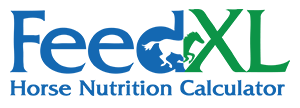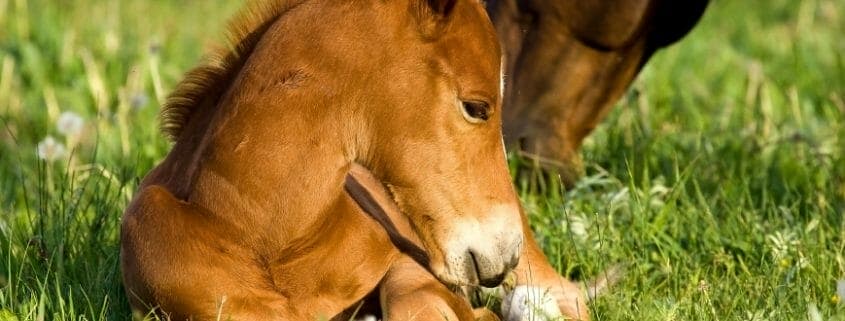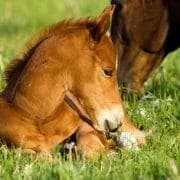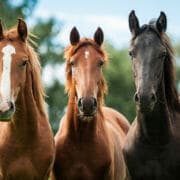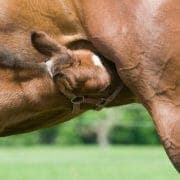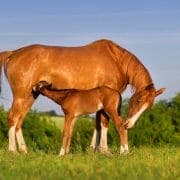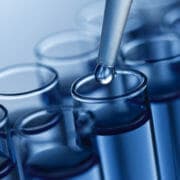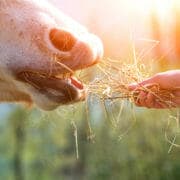Feeding for Sound Bones
Considerations when feeding a foal or young horse for sound bones
When breeding a young horse, one of the highest priorities, regardless of what the horse is being bred for, is to have the foal develop with strong bones and ‘clean’ legs, free from developmental disease and defects like osteochondritis dissecans (OCD). Developmental orthopaedic diseases (DODs) are known to be what is called ‘multifactoral’, or caused by multiple things. One of the best known and also easiest to manipulate causes is nutrition.
Unfortunately DOD and the role nutrition plays is not well understood in much of the breeding community. It is well known that overfeeding is a cause but unfortunately many a breeder’s answer to that is to not feed nearly enough and in doing so unwittingly causing problems through other mechanisms like mineral deficiencies. So how do you feed young horses for sound bones? Let us take a look…
Control growth rate
The one very predictable way to increase a horse’s risk of developmental bone diseases including OCD is to feed too much and make youngsters grow too fast. In this situation the young horse’s bones grow too quickly to be properly mineralised, or problems like contracted tendons and being over at the knees develop and put uneven pressure on growing bones and joints.
To minimise the risk of rapid growth rates causing problems with bone development, feeding regimes need to be closely controlled and adjusted as needed to match changing pasture and climate conditions and an individual horse’s requirements. Growth rates should be closely monitored through regular weighing where possible. The people responsible for feeding should also be observant, experienced and diligent, checking for signs of overfeeding and rapid rates of growth including excess body condition, physitis or any deviation in leg structure from normal in one or more of the horses in a group on a daily basis. As soon as any signs of overfeeding are noticed, feed regimes should be adjusted immediately to bring growth rates back in check.
In keeping growth rates in check however you also need to be really careful that you don’t hold youngsters back too much for fear of DOD. Horses that are stunted from an early age by overzealous control of their growth rates may never actually reach their full potential for growth at a later age … it is all a balancing act.
Mind your minerals
It is also well recognised that unbalanced mineral nutrition can lead to developmental issues in growing thoroughbreds. While a growing horse requires an extensive suite of minerals, minerals of particular importance for bone development are calcium, phosphorus, magnesium, copper, zinc and manganese. Not only do these minerals need to be supplied in the diet at correct levels, but they also need to be provided in the right ratios so that one mineral doesn’t block the absorption of the other (for example too much phosphorus will block the absorption of calcium, too much zinc will block the absorption of copper and too much potassium will block the absorption of magnesium).
Balancing the mineral component of growing horse rations is not a super simple task, but this is where FeedXL comes into play. FeedXL allows you to see if these mineral requirements are being met in a young horse’s diet and also if they are in the correct ratios to one another.
FeedXL also allows you to constantly adjust diets as a youngster’s growth rate changes allowing you to control growth rate (by increasing or decreasing feed amounts) without ever compromising mineral intakes.
Are there problems lurking in your pasture?
Because so much of a foal or young horse’s sound development is dependent on mineral intake, it is important to have your pasture (or hay) tested to assess its mineral status throughout the year. Pastures can have various characteristics that can quite quickly unbalance a diet and bring your entire feeding regime unstuck. Some examples from pastures that I have looked at in the past 12 months include:
- Unbalanced calcium to phosphorus ratio – Pastures that contain more phosphorus than calcium are more common than you would imagine and, if not corrected by careful calcium supplementation, can lead to a long-term calcium deficiency which will almost certainly disrupt sound bone development.
- Unbalanced zinc to copper ratio – Pastures that contain more than 5 parts zinc to 1 part copper put horses at risk of a copper deficiency. While not common, it is critical that this ratio is corrected through calculated supplementation to avoid copper deficiency.
- Extreme potassium content – Potassium contents upwards of 55 grams per kilogram of pasture dry matter have recently been recorded in horse pastures. While very little work has been done on the impact of this in horses, it is well recognised that potassium at these levels will disrupt the absorption and metabolism of both magnesium and calcium in other animal species and circumstantial evidence suggests this may be the case in horses.
- Mineral deficiencies – this is perhaps the most common problem seen in pastures. Calcium, copper and zinc are the three most common deficiencies seen of minerals important to bone development. Phosphorus and very occasionally manganese can also be too low to meet a growing horse’s requirements. Luckily this problem is also the easiest to correct through calculated supplementation with good quality feeds or pasture balancer pellets.
Because of all the spanners that pasture can throw into your feeding regime the first step toward putting together a well-balanced feeding regime for growing horses should always be pasture analysis. Here at FeedXL, we recommend you use Equi-Analytical (https://www.equi-analytical.com/) for your pasture analysis needs.
Provide good building blocks
Bone is built upon protein, both collagen and non-collagenous proteins, so it is reasonable to assume that the protein quality of the diet will have an impact on the quality and soundness of bone in growing horses. Feeding diets based on high quality protein will better support sound bone development than rations based on low quality sources of protein like cottonseed meal.
What about fancy stuff?
There are many supplements and feed additives on the market nowadays that will claim they can help reduce OCD and other bone issues. Some are backed by credible science, others aren’t. The key to using any of these supplements though, if you wish to give them a try, is to make sure you are feeding them with a well balanced diet, as no matter how good they are or claim to be, using them when other problems already exist in the diet is not going to give you better results. For example adding silica to diets that are deficient in copper is not going to solve any problems that may exist due to the copper deficiency.
There is still a lot we don’t know
While managing growth rates, feeding well-balanced diets that are formulated to suit pasture conditions, meeting all mineral requirements and feeding diets with high quality protein will give you the very best chance of producing a sound yearling, some horses will still develop bone issues, even under the very best conditions. It is also well recognised that some mares will consistently throw foals that go on to develop OCD or other issues. What we still don’t know is why – what is genetically different about these animals that puts them at much higher risk?
There is, however, a lot we do know and with some good management and the use of tools like pasture testing and FeedXL, you can dramatically reduce the risk of developmental orthopaedic diseases in your growing horses to produce sound, athletic horses for any equestrian discipline.
Do you have a question or comment? Do you need help with feeding?
We would love to welcome you to our FeedXL Horse Nutrition Facebook Group. Ask questions and have them answered by PhD and Masters qualified equine nutritionists and spend time with like-minded horse owners. It’s free!
Click here to join the FeedXL Horse Nutrition Facebook Group
